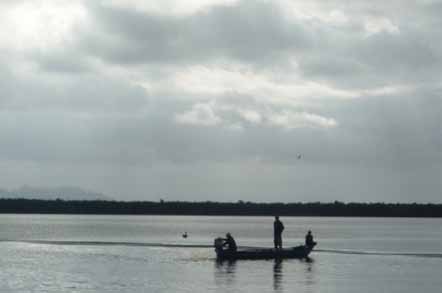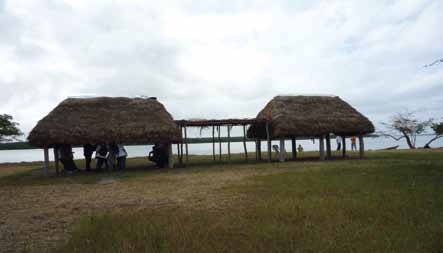Contents | 3 | 4 | 5 | 6 | 7 | 8 | 9 | 10 | 11 | 12 En español
Teacapán
Fishermen develop ecotourism
project
La Brecha looks for low impact activities

Faced with federal investment in the Pacific Coast Integrally Planned Center (CIP), fishermen develop a low impact tourism project.
Photo: Roberta Peralta
With the idea of creating jobs, during the last year the members of the fishing cooperative Sociedad Cooperativa de Producción Pesquera de Pescadores de La Brecha have arranged for financial aid to carry out community cleanups, installation of latrines and the construction of ecotourism infrastructure.
Their goal is to jumpstart the project they call Camichín, named for a tree found in the coastal zone of the Gulf of California. For the project, the cooperative has 6030 square feet in one corner of the estuary in the town of Teacapán known as La Brecha. They are seeking the financial backing to build 20 cabins, a restaurant and a floating pier for two boats, and to be able to provide land transport between the airport and hotels.
Conscious of the affluence of tourists in nearby Mazatlán and of the investment of about USD $560,000 being promoted by the federal government in the tourism megaproject Costa Pacífico in the outskirts of the county seat of Escuinapa, the cooperatives consider the reconversion of part of the declining fishing industry to be feasible with the help of the Agriculture and Livestock Secretary, Rural Development, Fishing and Food (Sagarpa), the National Fishing Commission, and the National Commission on Protected Natural Areas.
The cooperative formed so as to obtain “scaled fish” commercial fishing permits. It was formed in 1997 with 37 members and currently has 56 members. President Javier García Padilla and Treasurer José Ramón Andrade remember when the organization became the guardian of the estuaries out of the necessity to protect the very resource that was sustaining their families. They talk of how before there had been many problems with unscrupulous “outsiders”, fishermen who threw cyanide (a toxic chemical that kills everything including shrimp larvae and many other breeding species) into the estuaries.
Today, they say this no longer happens very often because of the increased patrols in these waters. The cooperative protects the deeper part of the estuary which is 7 fathoms deep and where oysters, shrimp larvae, mullet, Liseta mullet, snapper, snook, tarpon and crabs, among other species, can be found.
They also commented that there is a need for training so that they can successfully diversify their business since the project for the Pacific Coast Integrally Planned Center (CIP), conceived by Fonatur (the National Fund for the Promotion of Tourism), is just around the corner.
They believe that the CIP could benefit them if it brings jobs to Teacapán, but they question what is going to be done to protect the species found in the estuary when this enormous project is completed and the projected number of ships begin to arrive.
Mexican president Felipe Calderón announced the CIP megaproject in February 2009 on his visit to the municipality of Escuinapa, during the inauguration of a sculpture at the entrance to the land purchased for the CIP project from the Sinaloa government’s ruling families.
 Photo: Roberta Peralta
Photo: Roberta Peralta
“I know that the fishermen here in Escuinapa are concerned, that if the wetlands are ruined what might happen. I assure them that that’s not going to occur. We are going to save the wetlands as a natural ecosystem, something that people have to protect. And may this center be a magnet for their respect of the environment,” Calderón asserted.
One of the most recent in a series of CIP megaprojects coordinated by Fonatur in the past 25 years and with the goal of showering profits on the businesses involved in infrastructure, the project known as Costa Pacífico is projected to cover 5,884 acres, twice the surface area of the world famous Cancún CIP.
CETMar (Center for Marine Technology Studies) No. 23